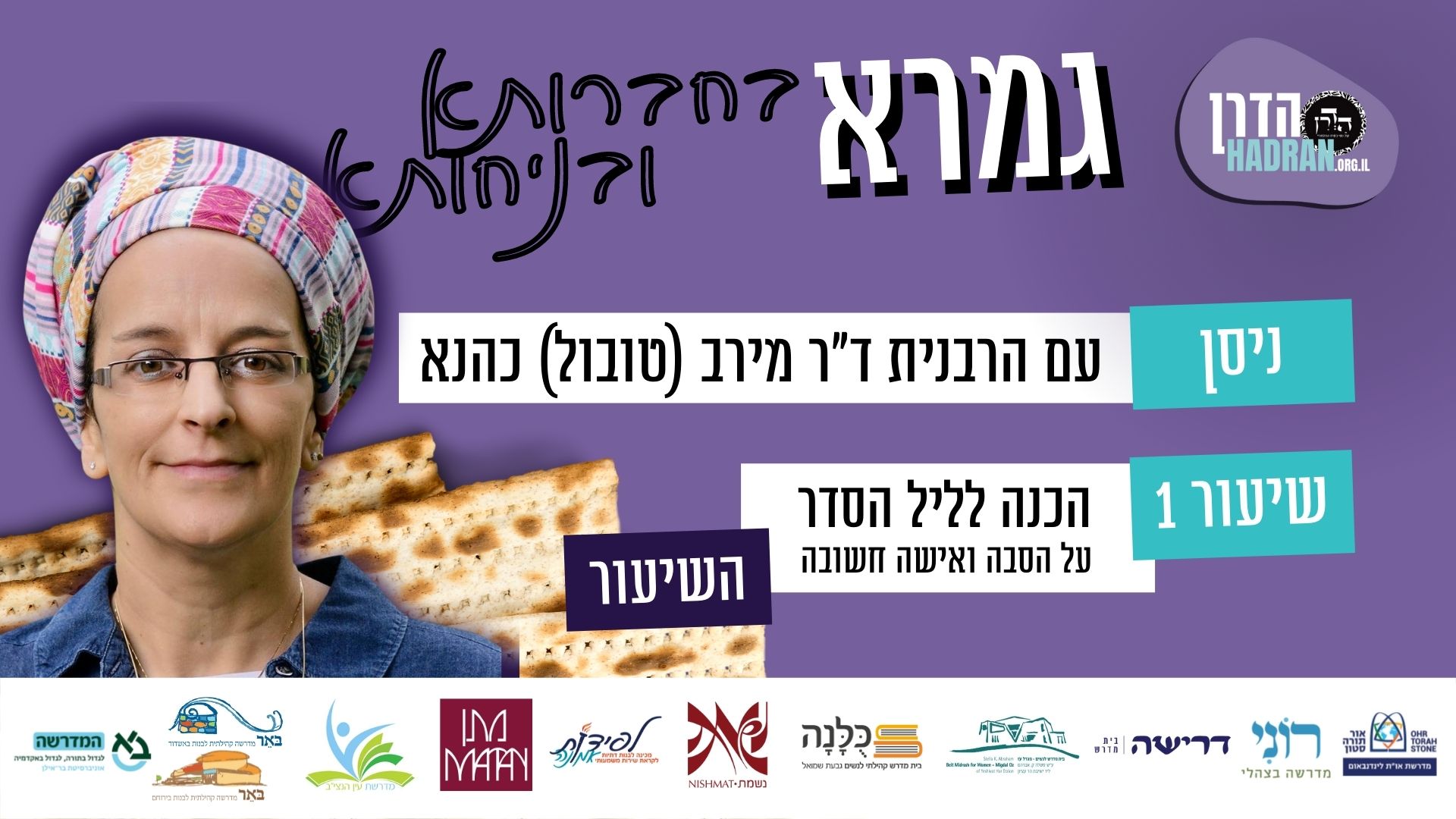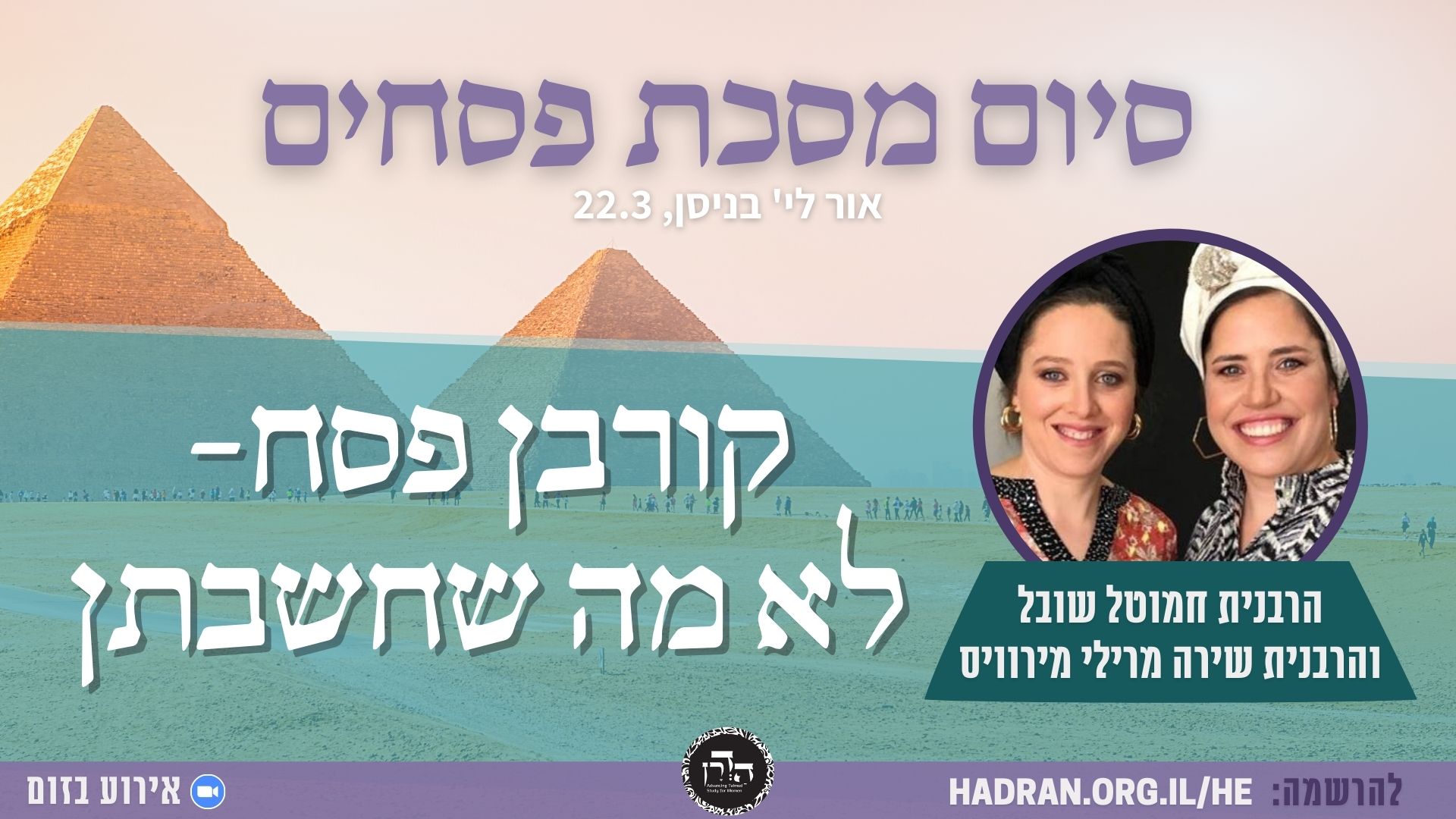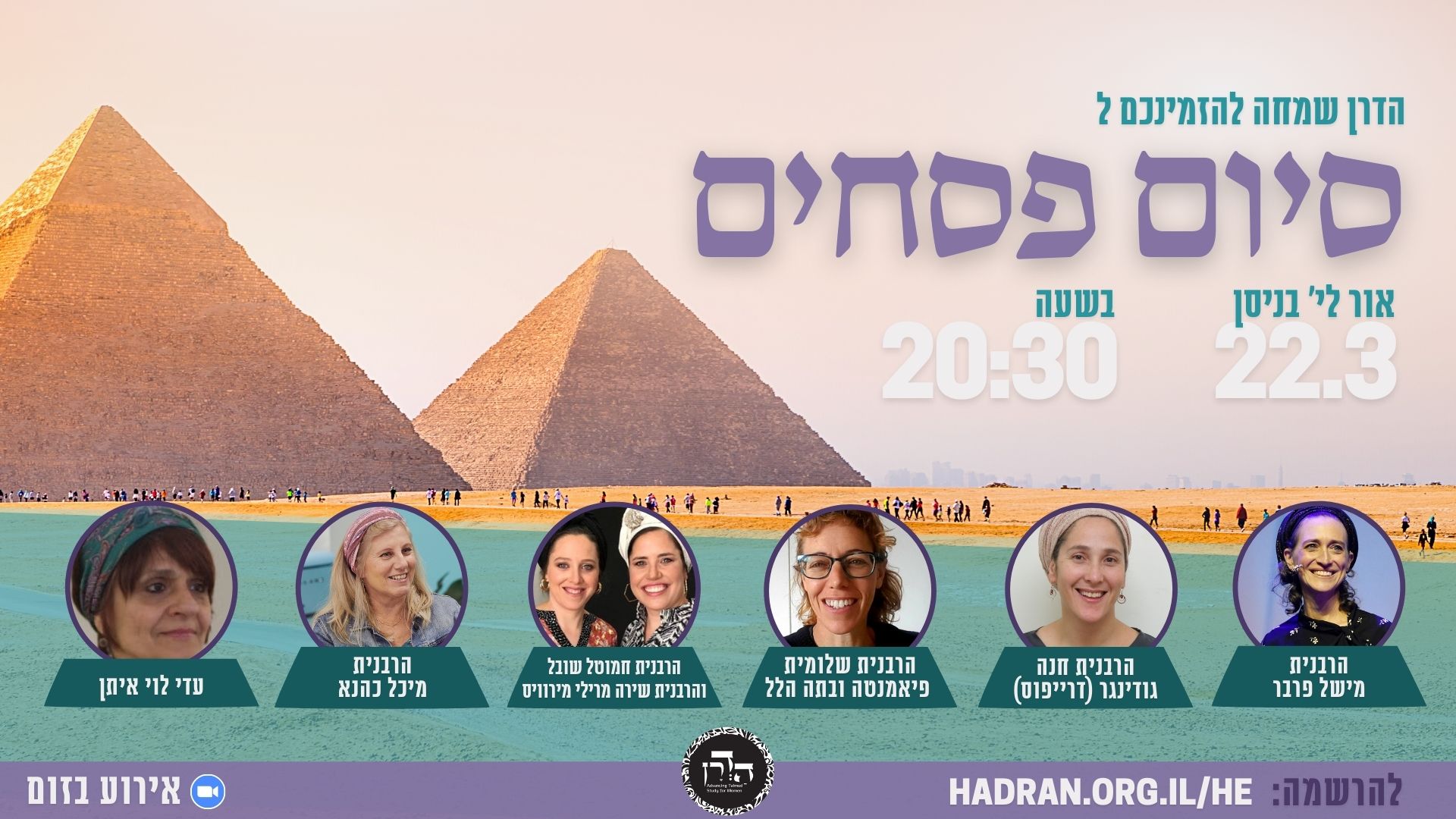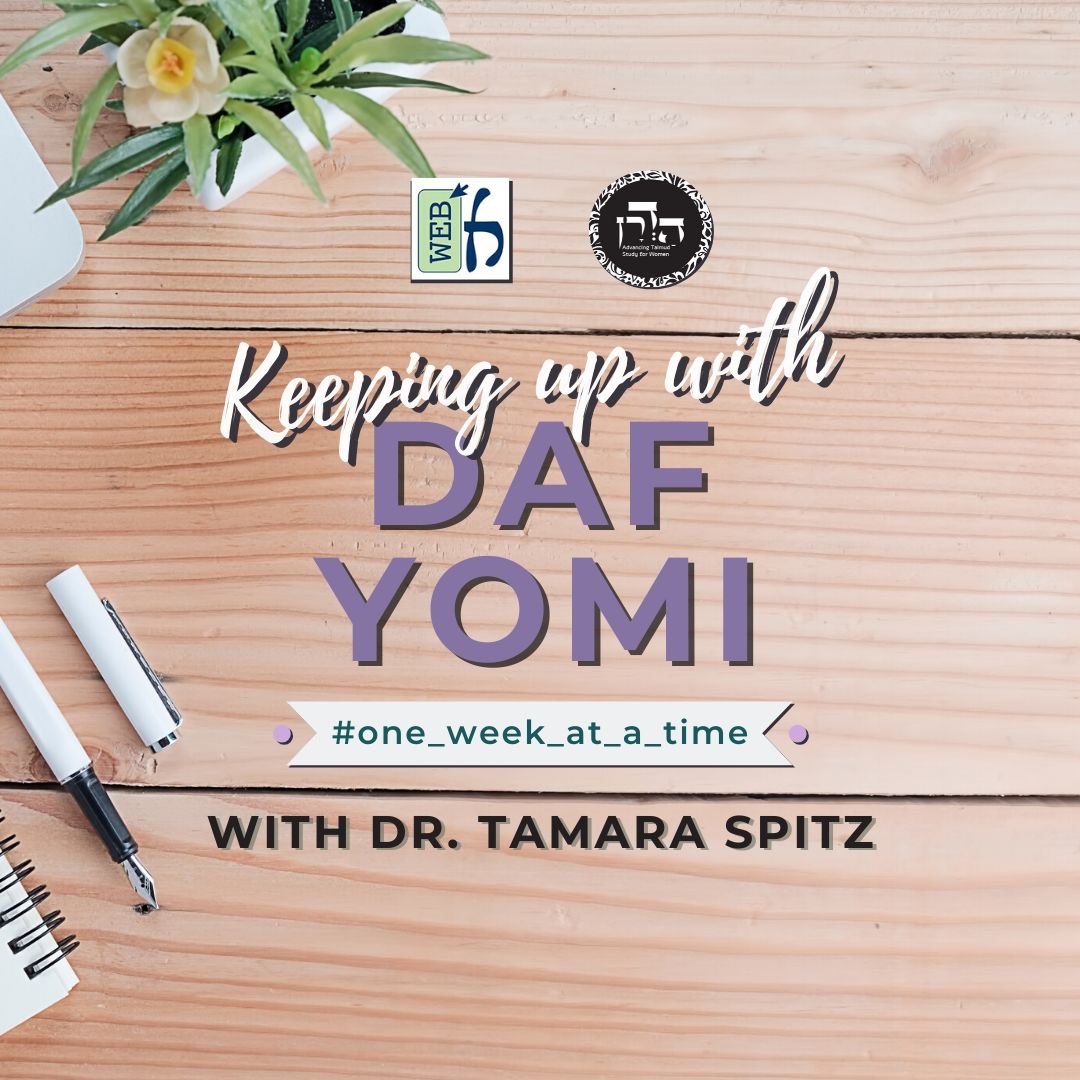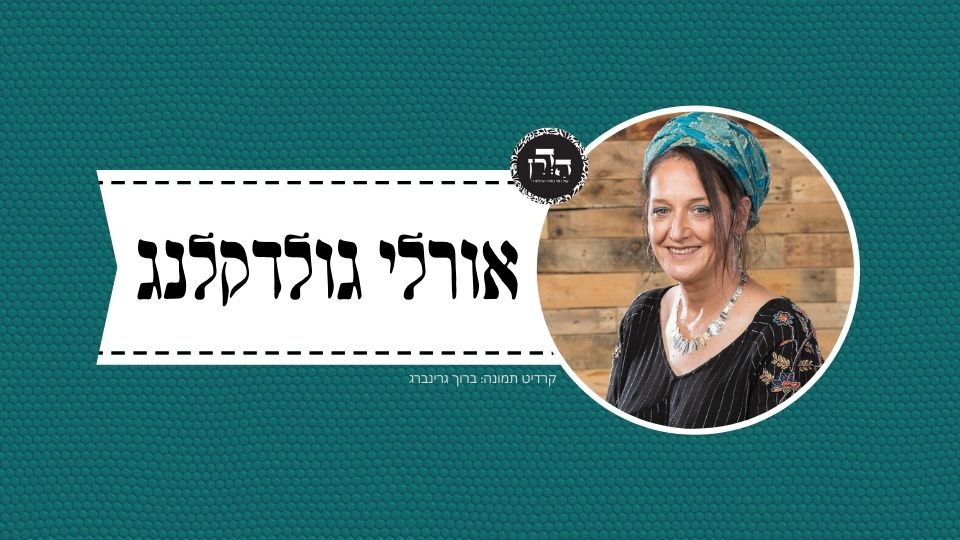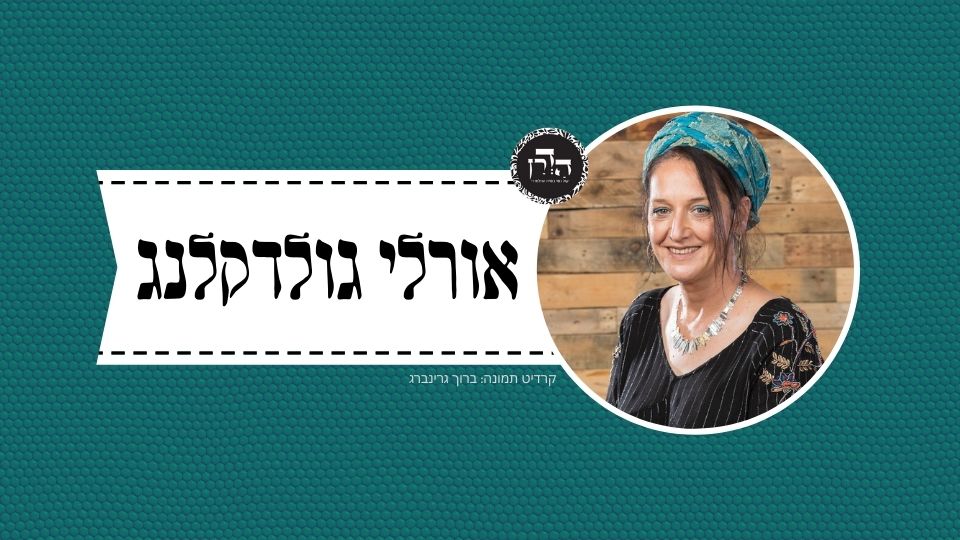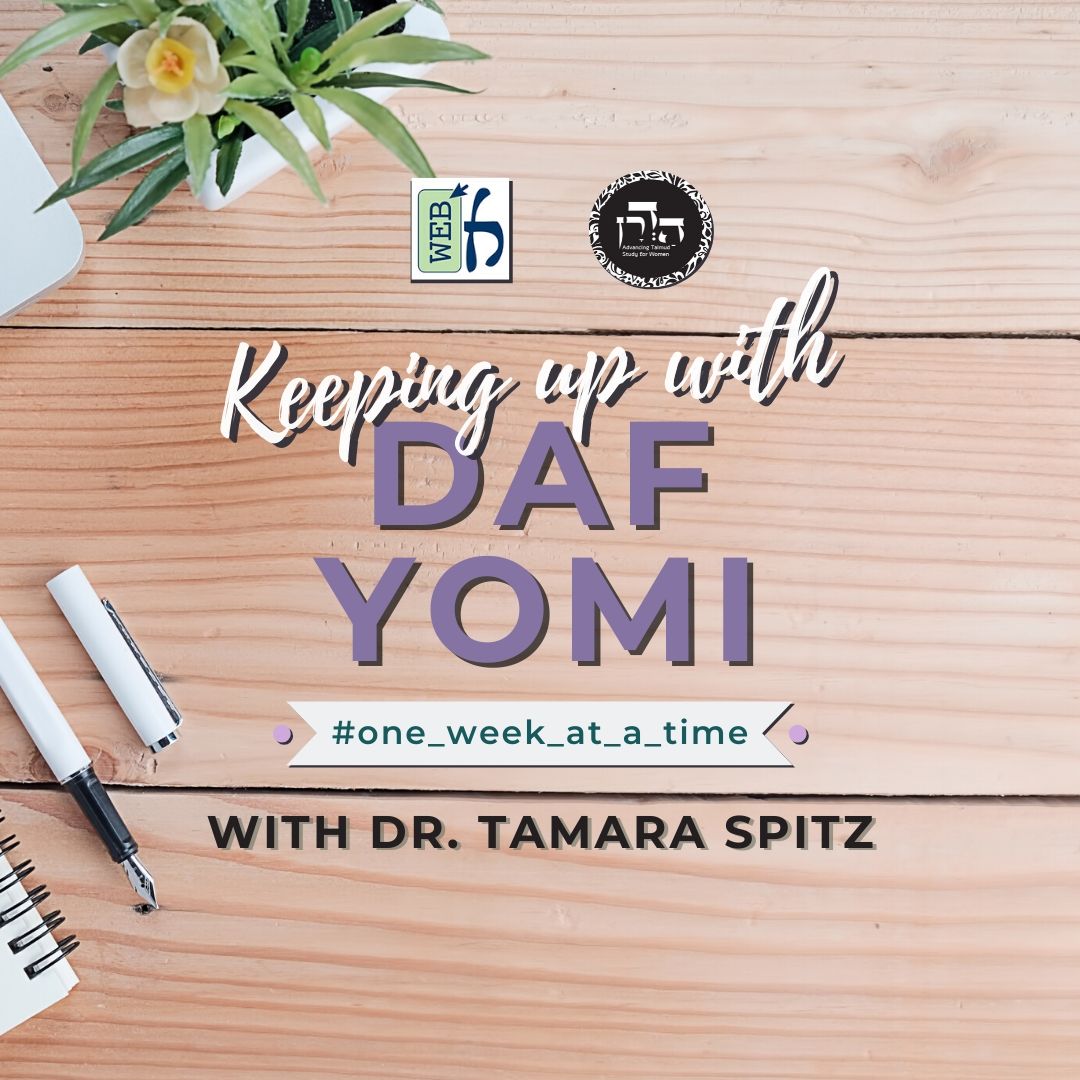פסחים פו
מַאי לָאו, דְּאָכְלִי בְּאִיגָּרָא וְאָמְרִי בְּאִיגָּרָא! לָא: דְּאָכְלִי בְּאַרְעָא וְאָמְרִי בְּאִיגָּרָא.
What, is it not the case that they eat the Paschal lamb on the roof and say hallel on the roof, which would mean that roofs have the sanctity of Jerusalem? The Gemara responds: No, there is no proof from here, as it is possible that they eat on the ground and say hallel on the roof.
אִינִי? וְהָתְנַן: אֵין מַפְטִירִין אַחַר הַפֶּסַח אֲפִיקוֹמָן, וְאָמַר רַב: שֶׁלֹּא יֵעָקְרוּ מֵחֲבוּרָה לַחֲבוּרָה. לָא קַשְׁיָא: כָּאן — בִּשְׁעַת אֲכִילָה, כָּאן — שֶׁלֹּא בִּשְׁעַת אֲכִילָה.
The Gemara asks: Is that so? But didn’t we learn in a mishna: We do not conclude after eating the Paschal lamb with afikoman, and Rav said that this means that after eating the Paschal lamb one may not say: Afikoman, which refers to removing the utensils in order to go eat somewhere else, because they may not uproot themselves from one group to another group. This would indicate that one must complete the entire Passover seder in one place. The Gemara answers: It is not difficult. Here, where it says that one may not change places, it is during the time of eating. There, where it says they would say hallel on the roof, it is not during the time of eating.
תָּא שְׁמַע, אַבָּא שָׁאוּל אוֹמֵר: עֲלִיַּית בֵּית קׇדְשֵׁי הַקֳּדָשִׁים חֲמוּרָה מִבֵּית קׇדְשֵׁי הַקֳּדָשִׁים. שֶׁבֵּית קׇדְשֵׁי הַקֳּדָשִׁים — כֹּהֵן גָּדוֹל נִכְנָס לוֹ פַּעַם אַחַת בַּשָּׁנָה, וַעֲלִיַּית בֵּית קׇדְשֵׁי הַקֳּדָשִׁים — אֵין נִכְנָסִין לָהּ אֶלָּא פַּעַם אַחַת בְּשָׁבוּעַ, וְאָמְרִי לַהּ: פַּעֲמַיִם בְּשָׁבוּעַ, וְאָמְרִי לַהּ: פַּעַם אַחַת בְּיוֹבֵל, לֵידַע מָה הִיא צְרִיכָה.
The Gemara attempts to bring another proof with regard to this issue. Come and hear a resolution to this issue based upon the following baraita: Abba Shaul says: The upper story of the chamber of the Holy of Holies is more stringent with regard to the prohibition to enter it than the chamber of the Holy of Holies itself. How so? With regard to the chamber of the Holy of Holies, the High Priest would enter it once a year on Yom Kippur in order to offer the incense and sprinkle the blood between the staves of the ark, whereas the upper story of the chamber of the Holy of Holies is not entered except for once in seven years; and some say twice in seven years, and some say just one time in a Jubilee, i.e., once in fifty years, to see what it needs in case there are renovations that must be done. This indicates that the sanctity of the upper story was even greater than that of the Sanctuary itself.
אָמַר רַב יוֹסֵף: מֵהֵיכָל נֵיקוּם וְנִיתֵּיב אִינִישׁ? שָׁאנֵי הֵיכָל, דִּכְתִיב: ״וַיִּתֵּן דָּוִד לִשְׁלֹמֹה בְנוֹ אֶת תַּבְנִית הָאוּלָם וְאֶת בָּתָּיו וְאֶת גַּנְזַכָּיו וַעֲלִיֹּתָיו וַחֲדָרָיו הַפְּנִימִים וּבֵית הַכַּפּוֹרֶת״, וּכְתִיב: ״הַכֹּל בִּכְתָב מִיַּד ה׳ עָלַי הִשְׂכִּיל״.
Rav Yosef said: Can a person get up and ask based on the Sanctuary? The Sanctuary is different, as it is written: “Then David gave to Solomon his son the pattern of the Entrance Hall of the Temple, and of its houses, and of its treasuries, and of its upper rooms, and of its inner chambers, and of the place of the ark cover” (I Chronicles 28:11), and it is written with regard to the plans for the construction of the Temple: “All this is put in writing by the hand of the Lord, Who has instructed me” (I Chronicles 28:19). Therefore, the general rules of sanctity of roofs do not apply to the Sanctuary, as the details of its construction were determined through divine inspiration.
תָּא שְׁמַע: הַלְּשָׁכוֹת הַבְּנוּיוֹת בַּקּוֹדֶשׁ וּפְתוּחוֹת לַחוֹל — תּוֹכָן חוֹל, וְגַגּוֹתֵיהֶן קוֹדֶשׁ! תַּרְגְּמָא רַב חִסְדָּא: בְּשֶׁגַּגּוֹתֵיהֶן שָׁוִין לְקַרְקַע עֲזָרָה.
Come and hear another possible proof based on the following mishna: With regard to the chambers in the Temple that were built in the sanctified area and open to the unsanctified area of the Temple Mount, their interiors are unsanctified and their roofs are sanctified. This states explicitly that the roofs are sanctified. The Gemara answers: Rav Ḥisda interpreted it as referring to chambers that were built under the Temple courtyard, and their roofs were level with the ground of the courtyard. In this case, the reason their roofs were sanctified is because they were part of the courtyard itself.
אִי הָכִי, אֵימָא סֵיפָא: בְּנוּיוֹת בַּחוֹל וּפְתוּחוֹת לַקּוֹדֶשׁ — תּוֹכֶן קוֹדֶשׁ וְגַגּוֹתֵיהֶן חוֹל. וְאִי סָלְקָא דַעְתָּךְ בְּשֶׁגַּגּוֹתֵיהֶן שָׁוִין לְקַרְקַע עֲזָרָה, הָוְיָא לַהּ מְחִילּוֹת, וְאָמַר רַבִּי יוֹחָנָן: מְחִילּוֹת לֹא נִתְקַדְּשׁוּ! כִּי קָאָמַר רַבִּי יוֹחָנָן — בִּפְתוּחוֹת לְהַר הַבַּיִת. כִּי תַּנְיָא הָהִיא — בִּפְתוּחוֹת לָעֲזָרָה.
The Gemara asks: If so, say the latter clause of the mishna as follows: If the chambers were built in the unsanctified area and open to the sanctified area, their interiors are sanctified and their roofs are unsanctified. And if it should enter your mind to say that this is referring to chambers whose roofs were level with the ground of the courtyard, such chambers would be tunnels, and Rabbi Yoḥanan said that the tunnels were not sanctified. The Gemara answers: When Rabbi Yoḥanan said that, he was referring to tunnels that were open to the Temple Mount; when that baraita, which says that the interiors were sanctified was taught, it was referring to rooms that open to the Temple courtyard itself.
וְהָתַנְיָא, רַבִּי יְהוּדָה אוֹמֵר: מְחִילּוֹת מִתַּחַת הַהֵיכָל חוֹל! כִּי תַּנְיָא הָהִיא — שֶׁפְּתוּחוֹת לַחוֹל.
The Gemara asks: But wasn’t it taught in a baraita that Rabbi Yehuda says: The tunnels under the Sanctuary are unsanctified? The Gemara answers: When that baraita was taught, it was pertaining to tunnels that open to the unsanctified area, which are considered unsanctified, as stated previously.
תָּא שְׁמַע: וְגַגּוֹ קוֹדֶשׁ!
The Gemara attempts another proof: Come and hear another proof from the same source cited above: It says in the baraita that the roof of the Sanctuary was sanctified, and the roof of the Sanctuary is not mentioned in the plans for the Temple laid out in the book of Chronicles. Therefore, the answer mentioned earlier, that everything in those plans was based upon divine inspiration, is not relevant. In that case, one should be able to derive that all the roofs were sanctified.
וְתִסְבְּרָא?! וְהָא קָתָנֵי: גַּגִּין הַלָּלוּ אֵין אוֹכְלִין שָׁם קׇדְשֵׁי קָדָשִׁים, וְאֵין שׁוֹחֲטִין שָׁם קָדָשִׁים קַלִּים! וְאֶלָּא קַשְׁיָא גַּגּוֹ קֹדֶשׁ! אָמַר רַב חָמָא בַּר גּוּרְיָא: לְאוֹתָן שְׁתֵּי אַמּוֹת.
The Gemara responds: And how can you understand it that way? Isn’t it teaching: In the case of these roofs of the courtyard and the chambers located there, one may not eat offerings of the most sacred order and one may not slaughter offerings of lesser sanctity there because they do not have the sanctity of the courtyard? However, that is difficult. It contradicts the previous statement that the roof is sanctified. Rav Ḥama bar Gurya said: The roof of the Sanctuary was considered sanctified only because those two measuring rods used to measure cubits were stored there.
דִּתְנַן: שְׁתֵּי אַמּוֹת הָיָה בְּשׁוּשַׁן הַבִּירָה, אַחַת עַל קֶרֶן מִזְרָחִית צְפוֹנִית וְאַחַת עַל קֶרֶן מִזְרָחִית דְּרוֹמִית. זוֹ שֶׁעַל קֶרֶן מִזְרָחִית צְפוֹנִית הָיְתָה יְתֵירָה עַל שֶׁל מֹשֶׁה חֲצִי אֶצְבַּע, וְזוֹ שֶׁעַל קֶרֶן מִזְרָחִית דְּרוֹמִית הָיְתָה יְתֵירָה עָלֶיהָ חֲצִי אֶצְבַּע, נִמְצֵאת יְתֵירָה עַל שֶׁל מֹשֶׁה אֶצְבַּע.
As we learned in a mishna: There were two rods for measuring cubits in the chamber called Shushan the Capital, one in the northeast corner and one in the southeast corner. The one in the northeast corner was longer than the cubit mentioned in the Torah from the time of Moses, which was six handbreadths, by half a fingerbreadth, and the one in the southeast corner was longer than that by another half a fingerbreadth. Consequently, the second measuring rod was longer than Moses’ cubit by a full fingerbreadth.
וְלָמָה הָיוּ אַחַת גְּדוֹלָה וְאַחַת קְטַנָּה? שֶׁיִּהְיוּ הָאוּמָּנִין נוֹטְלִין בַּקְּטַנָּה וּמַחְזִירִין בַּגְּדוֹלָה, כְּדֵי שֶׁלֹּא יָבוֹאוּ לִידֵי מְעִילָה. וְתַרְתֵּי לְמָה לִי? אַחַת — לְכַסְפָּא וְדַהֲבָא, וְאַחַת — לְבִנְיָנָא.
And why did they construct two measures for cubits, one large and one small? It was so that the artisans who were working in the Temple would take payment according the amount of work they did, as measured by the small cubit, and return it to the Temple through their work, as measured by the large cubit, so they would not come to misuse consecrated property. If they would accept any payment that they did not deserve, they would be misusing consecrated property. Therefore, this system of measuring was instituted in order to slightly reduce their payment and prevent accidental misuse of Temple funds. The Gemara asks: And why do I need two large cubits? The Gemara answers: One, the shorter of the two, was for silver and gold, so that the artisans would not lose too much, and one was for construction.
תְּנַן: הַחַלּוֹנוֹת וְעוֹבִי הַחוֹמָה — כְּלִפְנִים. בִּשְׁלָמָא הַחַלּוֹנוֹת, מַשְׁכַּחַתְּ לַהּ דְּשָׁוְיָה לְקַרְקַע עֲזָרָה. אֶלָּא עוֹבִי הַחוֹמָה, הֵיכִי מַשְׁכַּחַתְּ לַהּ?
We learned in the mishna: The space within the windows and the thickness of the wall were considered to be inside. The Gemara clarifies: Granted, with regard to the windows, you will find it to be sanctified with the sanctity of the Temple courtyard when it is level with the ground of the courtyard. But with regard to the thickness of the wall, which must have been significantly above the ground, under what circumstances can you find it to be level with the ground of the courtyard? Even the roofs of chambers in the courtyard were not sanctified; therefore, if the thickness of the wall was not level with the floor of the courtyard, it would certainly not have been sanctified.
מַשְׁכַּחַתְּ לַהּ בְּבַר שׁוּרָא, דִּכְתִיב: ״וַיַּאֲבֶל חֵל וְחוֹמָה״, וְאָמַר רַבִּי אַחָא וְאִיתֵּימָא רַבִּי חֲנִינָא: שׁוּרָא וּבַר שׁוּרָא.
The Gemara answers: You find it in the case of the low wall on the Temple Mount, which was the same height as the floor of the courtyard. This low wall is mentioned in the Bible, as it is written: “He has made the rampart and wall mourn” (Lamentations 2:8), and Rabbi Aḥa said, and some say it in the name of Rabbi Ḥanina, that this double language of both rampart and wall in the verse is referring to a wall and a low wall that were next to each other. This low wall was the same height as the floor of the courtyard.
מַתְנִי׳ שְׁתֵּי חֲבוּרוֹת שֶׁהָיוּ אוֹכְלִין בְּבַיִת אֶחָד, אֵלּוּ הוֹפְכִין אֶת פְּנֵיהֶם הֵילָךְ וְאוֹכְלִין, וְאֵלּוּ הוֹפְכִין אֶת פְּנֵיהֶם הֵילָךְ וְאוֹכְלִין, וְהַמֵּיחַם בָּאֶמְצַע. כְּשֶׁהַשַּׁמָּשׁ עוֹמֵד לִמְזוֹג, קוֹפֵץ אֶת פִּיו וּמַחֲזִיר אֶת פָּנָיו, עַד שֶׁמַּגִּיעַ אֵצֶל חֲבוּרָתוֹ וְאוֹכֵל. וְהַכַּלָּה הוֹפֶכֶת אֶת פָּנֶיהָ וְאוֹכֶלֶת.
MISHNA: Two groups that were eating one Paschal lamb in one house need not be concerned that they will appear to be one group. Rather, these turn their faces this way and eat, and these turn their faces that way and eat. And it is permissible for them to have the boiler from which they pour hot water in the middle, so that the waiter can easily serve both groups. When the attendant who is serving both groups gets up to pour for the group of which he is not a member, he must close his mouth and turn his face so that he does not accidentally eat with the other group, until he reaches his group again and eats with it. And the bride, who is embarrassed to eat in the presence of men she does not know, turns her face away from her group and eats, although this may make it seem as though she is part of a different group.
גְּמָ׳ מַתְנִיתִין מַנִּי? רַבִּי יְהוּדָה הִיא. דְּתַנְיָא: ״עַל הַבָּתִּים אֲשֶׁר יֹאכְלוּ אֹתוֹ בָּהֶם״, מְלַמֵּד שֶׁהַפֶּסַח נֶאֱכָל בִּשְׁתֵּי חֲבוּרוֹת. יָכוֹל יְהֵא הָאוֹכֵל אוֹכֵל בִּשְׁתֵּי מְקוֹמוֹת — תַּלְמוּד לוֹמַר: ״בְּבַיִת אֶחָד יֵאָכֵל״.
GEMARA: The Gemara asks: Who is the tanna of the mishna? The Gemara answers: It is Rabbi Yehuda. As it was taught in a baraita: The verse states: “Upon the houses wherein they shall eat it” (Exodus 12:7). This teaches that one Paschal lamb may be eaten in two separate groups, even if the groups eat it in separate houses. I might have thought that one person who eats from it may eat it in two separate places; therefore, the Torah states: “In one house shall it be eaten [ye’akhel]” (Exodus 12:46).
מִכָּאן אָמְרוּ: הַשַּׁמָּשׁ שֶׁאָכַל כְּזַיִת בְּצַד הַתַּנּוּר, אִי פִּקֵּחַ הוּא מְמַלֵּא כְּרֵיסוֹ מִמֶּנּוּ, וְאִם רָצוּ בְּנֵי חֲבוּרָה לַעֲשׂוֹת עִמּוֹ טוֹבָה — בָּאִין וְיוֹשְׁבִין בְּצִדּוֹ, דִּבְרֵי רַבִּי יְהוּדָה.
From here they stated that if an attendant who was registered for a Paschal lamb ate an olive-bulk of it next to the oven in which it is being roasted, and thereby made himself into an independent group at that location, if he is prudent he will fill his stomach with it because when the Paschal lamb is moved to a different location he will no longer be able to eat it. And if the members of the group wanted to do him a favor so that he may continue eating, they would come and sit at his side. This is the statement of Rabbi Yehuda.
רַבִּי שִׁמְעוֹן אוֹמֵר: ״עַל הַבָּתִּים אֲשֶׁר יֹאכְלוּ אֹתוֹ בָּהֶם״, מְלַמֵּד שֶׁהָאוֹכֵל אוֹכֵל בִּשְׁתֵּי מְקוֹמוֹת.
Rabbi Shimon says that the verses should be understood in the opposite manner: “Upon the houses wherein they shall eat it” teaches that one person who eats the Paschal lamb may eat it in two places.
יָכוֹל יְהֵא נֶאֱכָל בִּשְׁתֵּי חֲבוּרוֹת, תַּלְמוּד לוֹמַר: ״בְּבַיִת אֶחָד יֵאָכֵל״.
I might have thought that a single Paschal lamb may be eaten in two separate groups; therefore, the verse states: “In one house shall it be eaten.”
בְּמַאי קָמִיפַּלְגִי? רַבִּי יְהוּדָה סָבַר: יֵשׁ אֵם לַמָּסוֹרֶת. וְרַבִּי שִׁמְעוֹן סָבַר: יֵשׁ אֵם לַמִּקְרָא.
The Gemara asks: With regard to what principle do they disagree? The Gemara answers: Rabbi Yehuda holds that the consonantal text of the Torah is authoritative; meaning, the primary understanding of the verse is according to the way it is spelled. If this is the case, the verse may be rendered: In one house shall he eat it [yokhal], referring to the person eating the Paschal lamb. This would indicate that one eating from the Paschal lamb must eat in one location, but the verse does not prohibit dividing the offering between multiple groups. And Rabbi Shimon holds that the vocalized text of the Torah is authoritative. Since the word is pronounced ye’akhel, it is clear that it is referring to the Paschal lamb itself, and the verse requires that the offering be consumed by a single group of people (Rabbeinu Ḥananel).
הָיוּ יוֹשְׁבִין וְנִפְרְסָה מְחִיצָה בֵּינֵיהֶם, לְדִבְרֵי הָאוֹמֵר פֶּסַח נֶאֱכָל בִּשְׁתֵּי חֲבוּרוֹת — אוֹכְלִין, לְדִבְרֵי הָאוֹמֵר אֵין הַפֶּסַח נֶאֱכָל בִּשְׁתֵּי חֲבוּרוֹת — אֵין אוֹכְלִין.
The Gemara attempts to clarify this halakha: If members of a group were sitting and eating the Paschal lamb, and a partition was spread between them such that they now constitute two separate groups, according to Rabbi Yehuda, who says a Paschal lamb may be eaten in two groups, they may continue to eat; according to Rabbi Shimon, who says a Paschal lamb may not be eaten in two groups, they may not continue to eat because they now constitute two groups.
הָיוּ יוֹשְׁבִין וְנִסְתַּלְּקָה מְחִיצָה בֵּינֵיהֶן, לְדִבְרֵי הָאוֹמֵר הָאוֹכֵל אוֹכֵל בִּשְׁנֵי מְקוֹמוֹת — אוֹכְלִין, לְדִבְרֵי הָאוֹמֵר אֵין הָאוֹכֵל אוֹכֵל בִּשְׁנֵי מְקוֹמוֹת — אֵין אוֹכְלִין.
On the other hand, if they were sitting in two separate groups separated by a partition, and the partition between them was removed, according to Rabbi Shimon, who says that one who eats the Paschal lamb may eat it in two places, they may eat; according to Rabbi Yehuda, who says that one who eats the Paschal lamb may not eat it in two places, they may not eat. The removal of the partition defines a new place and it is as though they are eating in a new location.
יָתֵיב רַב כָּהֲנָא קָא פָּשֵׁיט לֵיהּ מִפְשָׁט. אֲמַר לֵיהּ רַב אָשֵׁי לְרַב כָּהֲנָא: וְתִיבְּעֵי לָךְ אִיבַּעְיָא: סִילּוּק מְחִיצָה וַעֲשִׂיַּית מְחִיצָה מִי הָוֵי כִּשְׁנֵי מְקוֹמוֹת, וְכִשְׁתֵּי חֲבוּרוֹת דָּמֵי, אוֹ לָא? תֵּיקוּ.
The Gemara relates that Rav Kahana sat and taught this lesson simply, as though it were absolutely clear that erecting a partition divides a group into two distinct groups and removing a partition causes the area to be regarded as a new location. Rav Ashi said to Rav Kahana: You should raise this dilemma as a question: Does removal of a partition or the construction of a partition in one location during the eating of the Paschal lamb render the place comparable to two locations and cause the people to be considered two groups, or not? In fact, there is no clear answer to this dilemma, and the Gemara concludes: Let the question stand unresolved.
הַכַּלָּה הוֹפֶכֶת אֶת פָּנֶיהָ וְכוּ׳. מַאי טַעְמָא? אָמַר רַבִּי חִיָּיא בַּר אַבָּא אָמַר רַבִּי יוֹחָנָן: מִפְּנֵי שֶׁהִיא בּוֹשָׁה.
It was taught in the mishna that a bride turns her face. The Gemara asks: What is the reason she turns her face? Rabbi Ḥiyya bar Abba said that Rabbi Yoḥanan said: It is because she is embarrassed by other members of the group looking at her.
רַב הוּנָא בְּרֵיהּ דְּרַב נָתָן אִיקְּלַע לְבֵי רַב נַחְמָן בַּר יִצְחָק. אֲמַרוּ לֵיהּ: מָה שְׁמָךְ? אֲמַר לְהוּ: רַב הוּנָא. אֲמַרוּ: נִיתֵּיב מָר אַפּוּרְיָא! יְתֵיב, יְהַבוּ לֵיהּ כָּסָא, קַבְּלֵיהּ בְּחַד זִימְנָא וְשַׁתְיֵיהּ בִּתְרֵי זִימְנֵי, וְלָא אַהְדַּר אַפֵּיהּ.
In this regard, the Gemara relates that Rav Huna, son of Rav Natan, happened to come to the house of Rav Naḥman bar Yitzḥak. They said to him: What is your name? He said to them: Rav Huna, even though using his title appeared to show conceit. They said: Our master may sit on the bed due to his great stature. He sat immediately, despite the fact that common etiquette dictated that he initially refuse. They gave him a cup of wine that he accepted the first time, without initially refusing it. And he drank it in two sips and did not turn his face from the rest of the people who were present.
אֲמַרוּ לֵיהּ: מַאי טַעְמָא קָרֵית לְךָ רַב הוּנָא? אֲמַר לְהוּ בַּעַל הַשֵּׁם אֲנִי. מַאי טַעְמָא כִּי אֲמַרוּ לָךְ נִיתֵּיב אַפּוּרְיָא יְתֵבְתְּ? אֲמַר לְהוּ: כׇּל מַה שֶׁיֹּאמַר לְךָ בַּעַל הַבַּיִת עֲשֵׂה (חוּץ מִצֵּא).
These actions all appeared to be departures from the common etiquette and surprised his hosts, who said to him: What is the reason you call yourself Rav Huna? He said to them: I am known by that name since my youth, and therefore referring to myself with that title does not indicate conceit. They asked him: What is the reason that when they told you to sit on the bed, you sat immediately and did not initially refuse? He said to them: We have learned that anything the master of the house says to you, you should do, except for an inappropriate request, such as if he says to leave.
מַאי טַעְמָא כִּי יָהֲבִי לָךְ כָּסָא קַבֵּלְתְּ בְּחַד זִימְנָא? אֲמַר לְהוּ: מְסָרְבִין לַקָּטָן, וְאֵין מְסָרְבִין לַגָּדוֹל. מַאי טַעְמָא אִשְׁתֵּיתֵיהּ בִּתְרֵי זִימְנֵי? אָמַר לְהוּ: דְּתַנְיָא, הַשּׁוֹתֶה כּוֹסוֹ בְּבַת אַחַת הֲרֵי זֶה גַּרְגְּרָן, שְׁנַיִם — דֶּרֶךְ אֶרֶץ, שְׁלֹשָׁה — מִגַּסֵּי הָרוּחַ. מַאי טַעְמָא לָא אַהְדַּרְתְּ אַפָּךְ? אֲמַר לְהוּ: ״כַּלָּה הוֹפֶכֶת פָּנֶיהָ״ תְּנַן.
They continued to question his conduct: What is the reason that when they gave you the cup, you accepted it the first time and did not politely demur? He said to them: One may refuse a lesser person, but one may not refuse a great person; when an important person makes a request, it is respectful to comply immediately. They persisted in their questioning: What is the reason you drank it in two sips? He said to them: As it was taught in a baraita: One who drinks his cup at one time is a guzzler; drinking it in two sips is proper manners; one who drinks his cup in three sips is haughty, as he thereby demonstrates that he is pampered and indulgent. They continued to question his conduct: What is the reason you did not turn your face in accordance with the common etiquette? He said to them: We learned in the mishna that a bride turns her face; however, there is no reason for anyone else to turn his face.
רַבִּי יִשְׁמָעֵאל בְּרַבִּי יוֹסֵי אִיקְּלַע לְבֵי רַבִּי שִׁמְעוֹן בְּרַבִּי יוֹסֵי בֶּן לָקוֹנְיָא. יְהַבוּ לֵיהּ כָּסָא, קַבְּלֵיהּ בְּחַד זִימְנָא וְשַׁתְיֵיהּ בְּחַד זִימְנָא. אָמְרִי לֵיהּ: לָא סָבַר לַהּ מָר הַשּׁוֹתֶה כּוֹסוֹ בְּבַת אַחַת הֲרֵי זֶה גַּרְגְּרָן? אֲמַר לְהוּ: לָא אָמְרִי בְּכוֹסְךָ קָטָן וְיֵינְךָ מָתוֹק וּכְרֵיסִי רְחָבָה.
The Gemara relates another incident that is somewhat similar to the one just quoted: Rabbi Yishmael, son of Rabbi Yosei, happened to come to the house of Rabbi Shimon, son of Rabbi Yosei ben Lakonya. They gave him a cup of wine to drink. He accepted it the first time it was offered and drank it at one time. They said to him: Does our master not hold of the halakha that one who drinks his cup at one time is a guzzler? He said to them: They did not say this rule with regard to your small cup, and your sweet wine, and my wide stomach.
אָמַר רַב הוּנָא: בְּנֵי חֲבוּרָה נִכְנָסִין בִּשְׁלֹשָׁה, וְיוֹצְאִין אֲפִילּוּ בְּאֶחָד. אָמַר רַבָּה: וְהוּא דְּעָיֵיל בְּעִידָּנָא דִּרְגִילִי לְמֵיעַל, וְהוּא דִּרְגַשׁ בְּהוּ דַּיָּילָא.
Rav Huna said: Members of a group enter with three, meaning that when there are three members present the waiter must start serving them, and they may leave even with one, meaning that they may leave one at a time, and the waiter must continue serving those who remain until they are finished. Rabba said: And that is true only when the last member of the group entered at a time when it is common to enter the meal and not unusually early or late, and it is true only when the waiter [dayyala] knew about them, i.e., he knew that the members of this group leave one by one as they finish their meals and do not eat the entire meal together.
אָמַר רָבִינָא: וְנוֹתְנִין שְׂכַר דָּמִים, וְצָרִיךְ הָאַחֲרוֹן לְהוֹסִיף דָּמִים. וְלֵית הִלְכְתָא כְּווֹתֵיהּ.
Ravina said: And the people who stayed late and extended their meal must give the waiter extra money for the wages he earned during the extra time that he served them, and the last one must add money for the time the waiter stayed to serve him individually. The Gemara notes: And the halakha is not in accordance with the opinion of Ravina. Rather, the waiter must serve until the last member of the group has completed his meal without additional compensation.
הַדְרָן עֲלָךְ כֵּיצַד צוֹלִין




